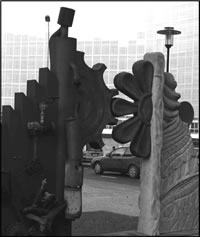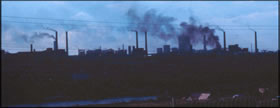 |
A sculpture in Brussels shows
the twinning between Industry and Nature |
A set of common rules on general operating permits for industrial installations
tries to reverse the currently unsustainable production patterns in Europe.
It also aims to prevent the so-called environmental dumping, i.e., the practice
of companies moving their manufacturing plants to those European countries
whose legislation may impose less strict environmental requirements. These
rules are set out in the Integrated Pollution Prevention and Control (IPPC)
Directive of 1996. In essence, the Directive requires that industrial installations
obtain an operating permit based on their demonstrated use of best available
techniques (BAT).
“Best available techniques are the most advanced technologies and
methods of operation that effectively reduce emissions to acceptable standards
to prevent their impact on the environment,” explains ICPDR expert
Mihaela Popovici.
The IPPC Directive builds on the principle of precaution and prevention
rather than “end-of-pipe” pollution abatement. It applies to
different industries ranging from chemical and metallurgical activities
to intensive poultry and pig rearing. “However, it does not cover
municipal wastewater treatment, mobile sources, or many smaller industrial
installations,” says Popovici.
According to Magnus Gislev of the European Commission (EC), “improvements
have been achieved in industry regarding several major polluting substances,
and the focus of environmental impact management is gradually shifting towards
diffusesources of pollution such as traffic and household consumption of
chemicals. However, industrial processes in Europe still account for a considerable
share of the overall pollution caused by greenhouse gases, acidifying substances,
and volatile organic compounds, and it is very important to further reduce
their impacts”.
 |
The IPPC Directive builds on the
principle of prevention rather than “end-of-pipe” pollution
abatement |
The IPPC Directive is yet another right step in that direction because
it requires that the overall environmental performance of a plant - its
emissions to air, water and land, generation of waste, use of raw materials,
energy efficiency, noise, prevention of accidents, risk management, etc.
- be taken into account before a permit is issued. It also requires that
a balanced decision be made on what constitutes BAT in each particular case,
taking into account costs to the operator, and advantages to the environment
of implementing an emission reduction measure.
The permit decision will be taken in a decentralised manner, as the authorities
have to take into account not only the technical characteristics of every
installation, but also its geographical location, and the local environmental
conditions. The fifteen EU Member States were given three years - until
the end of October 1999 - to adjust their national legislation and bring
it in line with the Directive. The new permitting system applies to any
new or substantially changed existing installations. It is gradually being
introduced to cover other existing installations and will fully apply from
October 2007 onwards.
Implementation difficulties not a "privilege"
of CEE countries
"Spurred by the EU enlargement process," says Gislev, "most
Central and Eastern European (CEE) countries have at least adopted the IPPC
Directive. However, when it comes to the actual implementation of the laws,
the European Commission has identified a number of serious problems arising
primarily from those countries' insufficient administrative capacities.
These problems are bigger in some countries than in others”.
Outdated technologies represent another major problem faced by CEE countries.
"We do not have a full overview of this problem,” says Gislev,
"but according to various studies the overall investment needs are
relatively higher in these countries than in Western Europe. In any case,
IPPC is undoubtedly reinforcing the current restructuring of industry in
Central and Eastern Europe."
According to the EU official, CEE countries should "recruit suitable
staff at the competent authorities and provide them with appropriate training.
The operating staff at installations to which the IPPC Directive applies
should also be trained to embrace the concept of shared responsibility introduced
by the Directive; at this point they are more used to the old-fashioned
command-and-control type of regulation".
"Adequate implementation of the IPPC Directive is a major challenge
for some current Member States, too," warns Gislev. “Some of
them actually face problems very similar to those encountered by CEE countries.
The single biggest challenge is to ensure compliance by all existing installations
by the end of October 2007,” he adds.
 |
Ispat-Sidex - a major industrial
plant on the Danube at Galati, Romania |
That implementation deadlines are not easy to meet is shown by the fact
that by December 2003 six current EU members had not yet produced the first
national implementation report for the 2000-2002 period. The EC announced
in January 2004 infringement proceedings against them. In the nine EU countries
that have made the reports, 3,820 integrated pollution permits were issued
in the first three years since the Directive entered into force covering
only 10% of those countries' total installations the Directive applies to.
The percentage of permits granted in the EU under the
IPPC Directive varies from 57% in Sweden to under
1% in Italy.
EU guidance
To assist the licensing authorities in complying with the Directive and
at the same time guide industry operators in the preparation of applications,
the European IPPC Bureau has organized an exchange of information among
EU Member States' experts, industry representatives and environmental NGOs,
whose cooperation will result in the production of BAT Reference Documents,
known as BREFs.
In the meantime, to better inform policy-makers and the public at large
about the amount of pollution caused by different installations, a European
Pollutant Emission Register, envisaged by the Directive, will be set up
and published on the Internet at the end of February this year.
Further information:
http://europa.eu.int/comm/environment/ippc
http://eper.cec.eu.int/eper